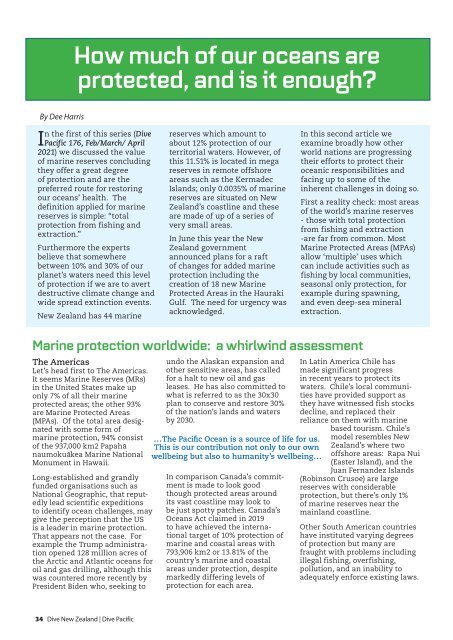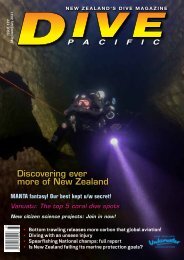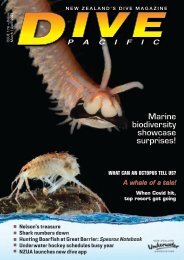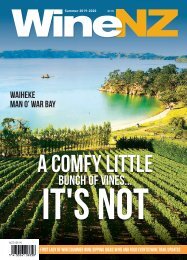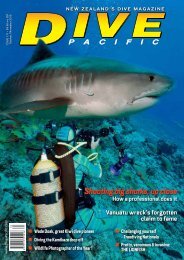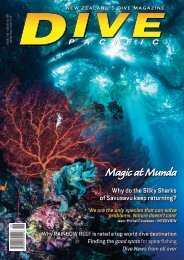DIVE PACIFIC 178 Sept-Nov 2021
Featuring Whale Shark at the door! (?), the threats from WWII wrecks in the Pacific, climate change impacts on kelp forests and coral reefs, new columns, superb u/w/photos and more
Featuring Whale Shark at the door! (?), the threats from WWII wrecks in the Pacific, climate change impacts on kelp forests and coral reefs, new columns, superb u/w/photos and more
Create successful ePaper yourself
Turn your PDF publications into a flip-book with our unique Google optimized e-Paper software.
How much of our oceans are<br />
protected, and is it enough?<br />
By Dee Harris<br />
In the first of this series (Dive<br />
Pacific 176, Feb/March/ April<br />
<strong>2021</strong>) we discussed the value<br />
of marine reserves concluding<br />
they offer a great degree<br />
of protection and are the<br />
preferred route for restoring<br />
our oceans’ health. The<br />
definition applied for marine<br />
reserves is simple: “total<br />
protection from fishing and<br />
extraction.”<br />
Furthermore the experts<br />
believe that somewhere<br />
between 10% and 30% of our<br />
planet’s waters need this level<br />
of protection if we are to avert<br />
destructive climate change and<br />
wide spread extinction events.<br />
New Zealand has 44 marine<br />
reserves which amount to<br />
about 12% protection of our<br />
territorial waters. However, of<br />
this 11.51% is located in mega<br />
reserves in remote offshore<br />
areas such as the Kermadec<br />
Islands; only 0.0035% of marine<br />
reserves are situated on New<br />
Zealand’s coastline and these<br />
are made of up of a series of<br />
very small areas.<br />
In June this year the New<br />
Zealand government<br />
announced plans for a raft<br />
of changes for added marine<br />
protection including the<br />
creation of 18 new Marine<br />
Protected Areas in the Hauraki<br />
Gulf. The need for urgency was<br />
acknowledged.<br />
In this second article we<br />
examine broadly how other<br />
world nations are progressing<br />
their efforts to protect their<br />
oceanic responsibilities and<br />
facing up to some of the<br />
inherent challenges in doing so.<br />
First a reality check: most areas<br />
of the world’s marine reserves<br />
- those with total protection<br />
from fishing and extraction<br />
-are far from common. Most<br />
Marine Protected Areas (MPAs)<br />
allow ‘multiple’ uses which<br />
can include activities such as<br />
fishing by local communities,<br />
seasonal only protection, for<br />
example during spawning,<br />
and even deep-sea mineral<br />
extraction.<br />
Marine protection worldwide: a whirlwind assessment<br />
The Americas<br />
Let’s head first to The Americas.<br />
It seems Marine Reserves (MRs)<br />
in the United States make up<br />
only 7% of all their marine<br />
protected areas; the other 93%<br />
are Marine Protected Areas<br />
(MPAs). Of the total area designated<br />
with some form of<br />
marine protection, 94% consist<br />
of the 937,000 km2 Papahā<br />
naumokuākea Marine National<br />
Monument in Hawaii.<br />
Long-established and grandly<br />
funded organisations such as<br />
National Geographic, that reputedly<br />
lead scientific expeditions<br />
to identify ocean challenges, may<br />
give the perception that the US<br />
is a leader in marine protection.<br />
That appears not the case. For<br />
example the Trump administration<br />
opened 128 million acres of<br />
the Arctic and Atlantic oceans for<br />
oil and gas drilling, although this<br />
was countered more recently by<br />
President Biden who, seeking to<br />
undo the Alaskan expansion and<br />
other sensitive areas, has called<br />
for a halt to new oil and gas<br />
leases. He has also committed to<br />
what is referred to as the 30x30<br />
plan to conserve and restore 30%<br />
of the nation’s lands and waters<br />
by 2030.<br />
…The Pacific Ocean is a source of life for us.<br />
This is our contribution not only to our own<br />
wellbeing but also to humanity’s wellbeing…<br />
In comparison Canada’s commitment<br />
is made to look good<br />
though protected areas around<br />
its vast coastline may look to<br />
be just spotty patches. Canada’s<br />
Oceans Act claimed in 2019<br />
to have achieved the international<br />
target of 10% protection of<br />
marine and coastal areas with<br />
793,906 km2 or 13.81% of the<br />
country’s marine and coastal<br />
areas under protection, despite<br />
markedly differing levels of<br />
protection for each area.<br />
In Latin America Chile has<br />
made significant progress<br />
in recent years to protect its<br />
waters. Chile’s local communities<br />
have provided support as<br />
they have witnessed fish stocks<br />
decline, and replaced their<br />
reliance on them with marine<br />
based tourism. Chile’s<br />
model resembles New<br />
Zealand’s where two<br />
offshore areas: Rapa Nui<br />
(Easter Island), and the<br />
Juan Fernandez Islands<br />
(Robinson Crusoe) are large<br />
reserves with considerable<br />
protection, but there’s only 1%<br />
of marine reserves near the<br />
mainland coastline.<br />
Other South American countries<br />
have instituted varying degrees<br />
of protection but many are<br />
fraught with problems including<br />
illegal fishing, overfishing,<br />
pollution, and an inability to<br />
adequately enforce existing laws.<br />
34 Dive New Zealand | Dive Pacific


